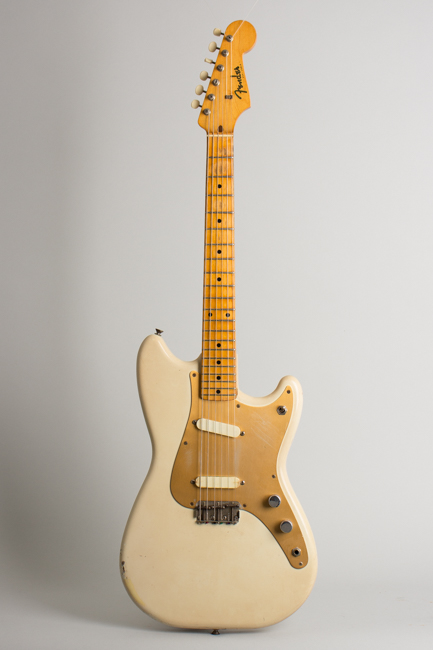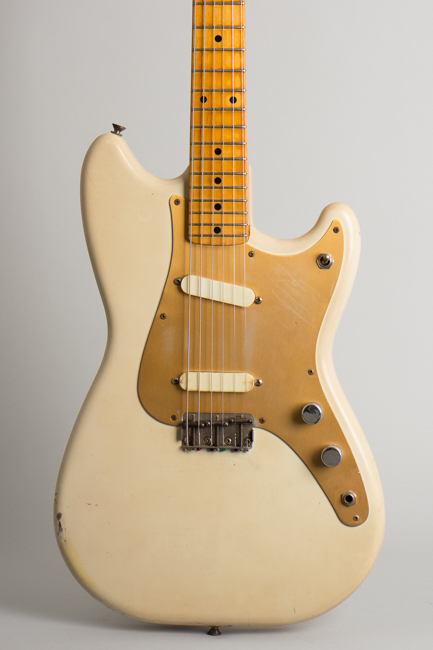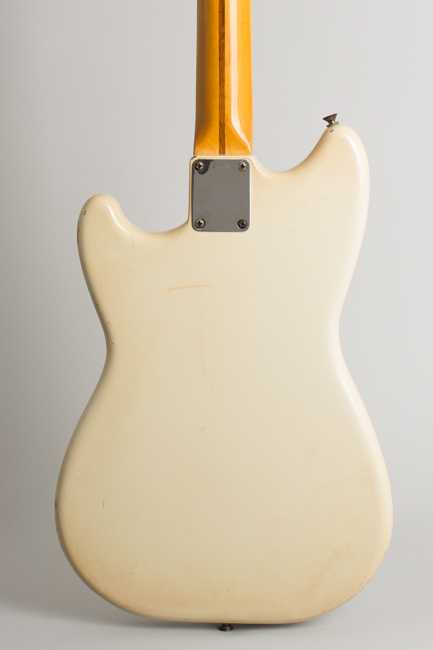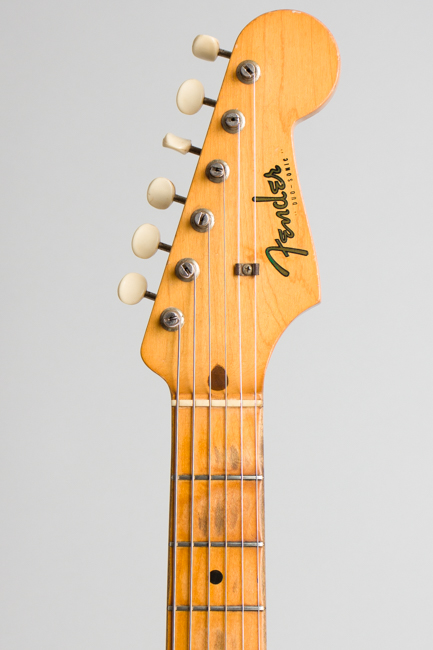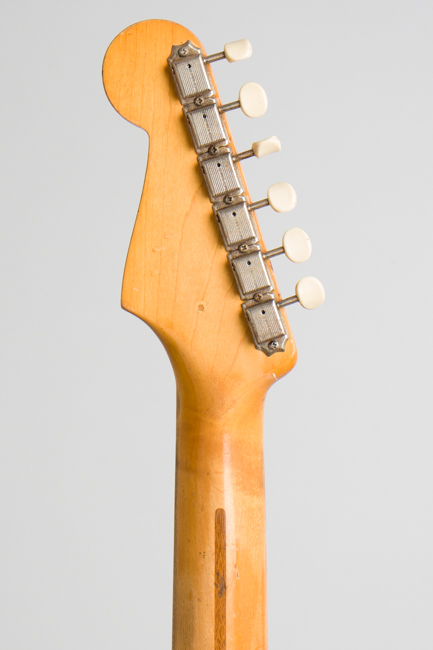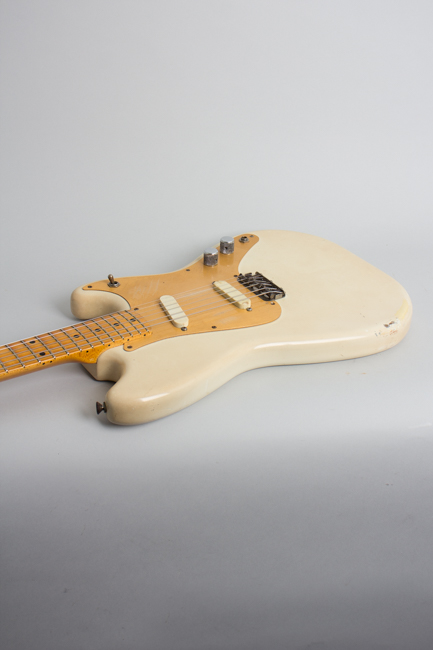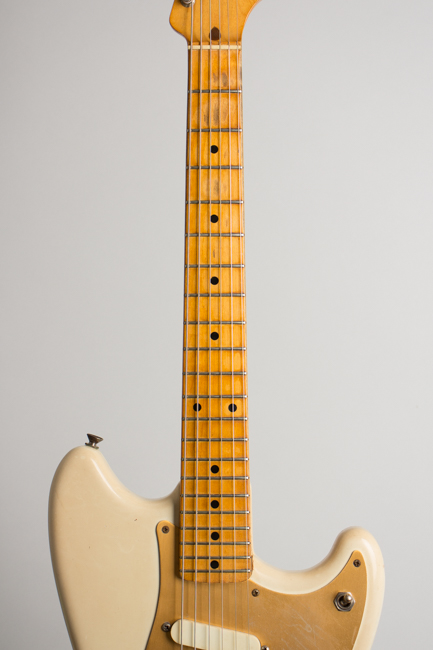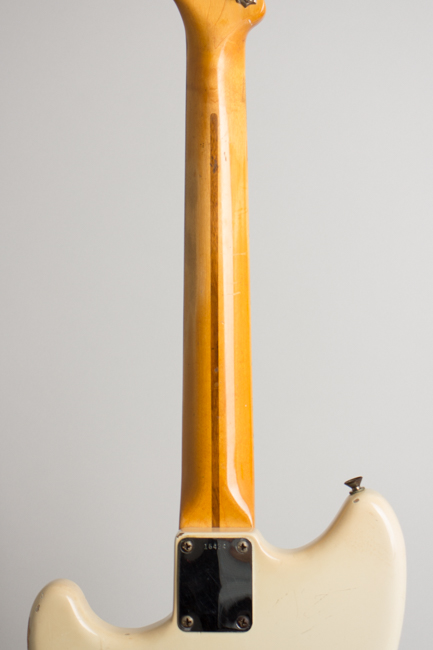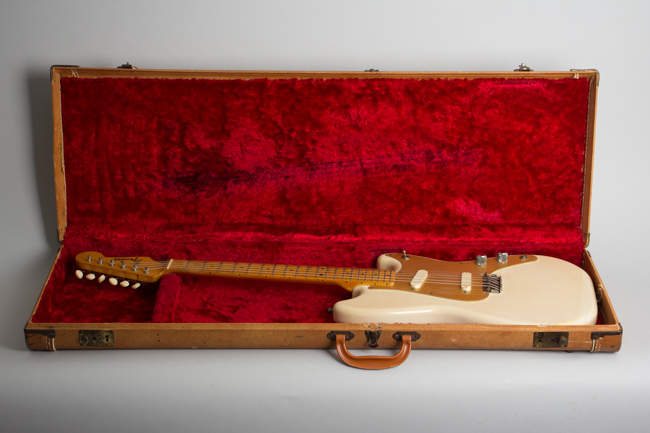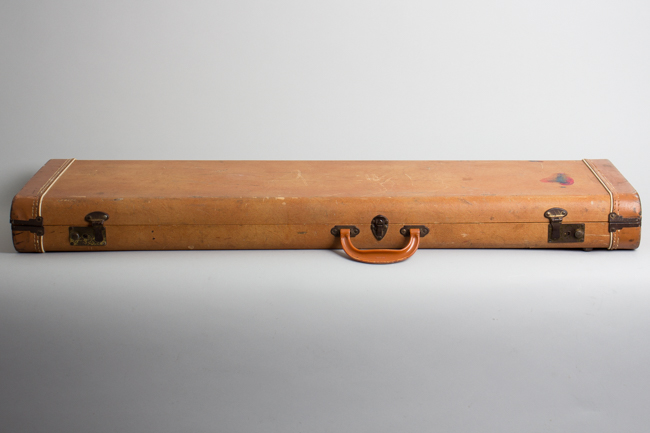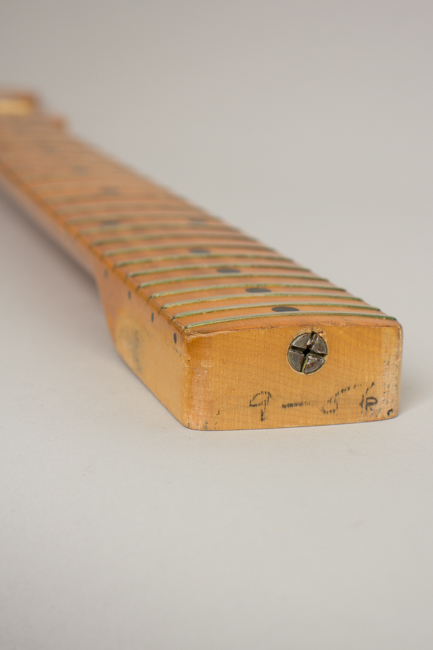Fender Duo-Sonic Solid Body Electric Guitar (1956)
This item has been sold.
Item # 11653
Prices subject to change without notice.
Fender Duo-Sonic Model Solid Body Electric Guitar (1956), made in Fullerton, California, serial # 16424, off-white lacquer re- finish, alder body, maple neck, original brown hard shell case.
This is a very early example of Fender's first two pickup student guitar: the unjustly obscure Duo-Sonic. This one was made in late 1956 and has an ancient (and very authentic looking) refinish on the body only, with some "real relic' wear and mojo to spare!
Christened with one of Fenders coolest names ever, this little package of electric goodness was designed to expand the company's position the teaching studio/young student market. By the late '50s interest in the Hawaiian steel guitar was on the wane, and the kids coming in for guitar lessons wanted to rock'n'roll. A two-pickup version of the very basic Musicmaster seemed like an easy solution, so The Duo-Sonic was duly introduced in the second half of 1956. This is one of the earlier examples we have ever seen.
The Duo-sonic is built from all the same components as the Musicmaster with a second pickup at the bridge, an attendant selector switch and single volume and tone controls. It features a short 22 1/2" scale maple neck and smaller alder body, originally finished in a shade Fender called "Desert Sand". The three-saddle bridge uses the same components as the Telecaster with a smaller baseplate stringing from the back edge; this one is old enough to have smooth steel saddles pre-dating the serrated versions usually seen. The pickups are the same basic forms as Stratocaster units, in white plastic covers without exposed polepieces.
This guitar has the original electronics featuring pots from the 20th week of 1956. The original anodized metal pickguard has some light wear but still looks sharp! The guitar has survived intact without being stripped of its more valuable parts (knobs, neckplate, pots, and wiring) as so many have. The neat, comfortable little neck is dated 9-56 in pencil on the heel and has an early iteration of the classic '57 Fender "V" profile.
These guitars were many 1950s and '60s players' first electric, far more playable than most other options and stylish in an understated way. They were designed to be good enough to get kids hooked on playing electric, but not so flashy as to stop them still lusting after a new Stratocaster down the road! The short scale is not what many modern players are used to but nonetheless this is a very cool genuine 1950s Fender guitar that plays and sounds great. As the prices of other Fender guitars have risen the Duo-Sonic has remained the best relative bargain in a genuine Fender guitar from the first Fullerton epoch.
Overall length is 37 5/8 in. (95.6 cm.), 12 1/4 in. (31.1 cm.) wide at lower bout, and 1 1/2 in. (3.8 cm.) in depth, measured at side of rim. Scale length is 22 1/2 in. (572 mm.). Width of nut is 1 5/8 in. (41 mm.).
Apart from the very old body-only refinish this first-generation Duo Sonic remains in original condition, played in with some typical wear. The body finish is a whiter lacquer than the original Desert Sand color but has "curdled' to a pretty close approximation of the correct look. It has general wear including dings, dents and chips, most notably on the bottom edge. The neck finish remains original; there are spots worn through the lacquer most heavily along the treble edge, with some typical fingerboard wear in the lower positions. The decal is very well preserved.
The guitar retains its original parts and hardware, including the Kluson tuners, early smooth-saddle bridge, knobs, both pickups and all electronics. The bridge pickup cover has small cracks on the top near the edges but is still solid. Some of the lacquer has been strummed off the pickguard, but it mostly retains good color with only some very small spots down to the metal. The original small frets show some light wear but still play fine. The pickups are loud and strong, and this is a far better sounding guitar than many give these credit for. Even considering the ancient refin this is a cool piece of Fender history and a fun guitar to play, still in its worn-but-functional original tan '50s case. Overall Very Good + Condition.
This is a very early example of Fender's first two pickup student guitar: the unjustly obscure Duo-Sonic. This one was made in late 1956 and has an ancient (and very authentic looking) refinish on the body only, with some "real relic' wear and mojo to spare!
Christened with one of Fenders coolest names ever, this little package of electric goodness was designed to expand the company's position the teaching studio/young student market. By the late '50s interest in the Hawaiian steel guitar was on the wane, and the kids coming in for guitar lessons wanted to rock'n'roll. A two-pickup version of the very basic Musicmaster seemed like an easy solution, so The Duo-Sonic was duly introduced in the second half of 1956. This is one of the earlier examples we have ever seen.
The Duo-sonic is built from all the same components as the Musicmaster with a second pickup at the bridge, an attendant selector switch and single volume and tone controls. It features a short 22 1/2" scale maple neck and smaller alder body, originally finished in a shade Fender called "Desert Sand". The three-saddle bridge uses the same components as the Telecaster with a smaller baseplate stringing from the back edge; this one is old enough to have smooth steel saddles pre-dating the serrated versions usually seen. The pickups are the same basic forms as Stratocaster units, in white plastic covers without exposed polepieces.
This guitar has the original electronics featuring pots from the 20th week of 1956. The original anodized metal pickguard has some light wear but still looks sharp! The guitar has survived intact without being stripped of its more valuable parts (knobs, neckplate, pots, and wiring) as so many have. The neat, comfortable little neck is dated 9-56 in pencil on the heel and has an early iteration of the classic '57 Fender "V" profile.
These guitars were many 1950s and '60s players' first electric, far more playable than most other options and stylish in an understated way. They were designed to be good enough to get kids hooked on playing electric, but not so flashy as to stop them still lusting after a new Stratocaster down the road! The short scale is not what many modern players are used to but nonetheless this is a very cool genuine 1950s Fender guitar that plays and sounds great. As the prices of other Fender guitars have risen the Duo-Sonic has remained the best relative bargain in a genuine Fender guitar from the first Fullerton epoch.
Overall length is 37 5/8 in. (95.6 cm.), 12 1/4 in. (31.1 cm.) wide at lower bout, and 1 1/2 in. (3.8 cm.) in depth, measured at side of rim. Scale length is 22 1/2 in. (572 mm.). Width of nut is 1 5/8 in. (41 mm.).
Apart from the very old body-only refinish this first-generation Duo Sonic remains in original condition, played in with some typical wear. The body finish is a whiter lacquer than the original Desert Sand color but has "curdled' to a pretty close approximation of the correct look. It has general wear including dings, dents and chips, most notably on the bottom edge. The neck finish remains original; there are spots worn through the lacquer most heavily along the treble edge, with some typical fingerboard wear in the lower positions. The decal is very well preserved.
The guitar retains its original parts and hardware, including the Kluson tuners, early smooth-saddle bridge, knobs, both pickups and all electronics. The bridge pickup cover has small cracks on the top near the edges but is still solid. Some of the lacquer has been strummed off the pickguard, but it mostly retains good color with only some very small spots down to the metal. The original small frets show some light wear but still play fine. The pickups are loud and strong, and this is a far better sounding guitar than many give these credit for. Even considering the ancient refin this is a cool piece of Fender history and a fun guitar to play, still in its worn-but-functional original tan '50s case. Overall Very Good + Condition.
